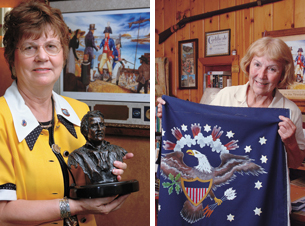 Two decades ago, Ray and Phyllis Yeager moved from Montana where they’d lived most of their lives to the knobs of Southern Indiana. Sometime later, Phyllis came across a historical marker on the banks of the Ohio River in Clarksville that piqued her interest.
Two decades ago, Ray and Phyllis Yeager moved from Montana where they’d lived most of their lives to the knobs of Southern Indiana. Sometime later, Phyllis came across a historical marker on the banks of the Ohio River in Clarksville that piqued her interest.
The marker stood seemingly unnoticed by most passersby and isolated — all but for an occasional piece of driftwood or debris the river would deposit. The marker simply stated that near that spot on Oct. 26, 1803, Meriwether Lewis and William Clark set off together with the nucleus of the Corps of Discovery to explore the Louisiana Purchase and the Pacific Northwest.
For Yeager, a Harrison REMC consumer, it was more than a mere curiosity.
All her life she grew up with the Lewis and Clark legacy all around her in Montana’s Big Sky Country. Her grandfather told her the stories of the extraordinary expedition. National forests and mountain peaks she could see from her ranch were named for the famed explorers and members of the Corps. And now here, near her Indiana home, was the headwater, the launch site, of this historic “Voyage of Discovery.”
While few but the hard core Lewis and Clark enthusiasts and history buffs locally seemed aware or to care, Yeager took great pride in showing visiting friends and relatives from back home this newfound piece of Lewis and Clark lore. She said some, though, would almost scoff at the notion. How can that be? What does Indiana have to do with Lewis and Clark?
The answer: a lot. That’s what most people near the Falls of the Ohio, around Indiana and across the nation have learned the last few years.
The journey begins
Though it was practically overlooked until the Lewis and Clark Expedition Bicentennial Commemoration rolled around in 2003, Meriwether Lewis first met up with his handpicked co-leader of the expedition, William Clark, at the Falls of the Ohio. Here, their two names became linked for the first time — and forever after.
Conceptually, the military expedition began in the mind of Thomas Jefferson many years earlier. Jefferson wanted the uncharted parts of the continent to the Pacific Ocean thoroughly explored. After becoming president in 1801, he put the expedition in motion. In 1802, he asked Lewis, his 28-year-old close friend and aide, to lead it.
In June of 1803, Lewis wrote Clark, his friend and former rifle company commander, asking him to join the expedition as co-captain. Clark accepted the offer.
At the time, Clark, 32, was living in a cabin atop a bluff overlooking the Ohio River in Clarksville with his older brother, Revolutionary War hero Gen. George Rogers Clark. While waiting for Lewis to arrive from Pittsburgh with boats and provisions for the expedition, he began recruiting frontiersmen from the Louisville-Clarksville area.
Lewis arrived at the Falls of the Ohio on Oct. 14, 1803. The next day, once around the river’s tricky series of drops, he tied up at the mouth of Mill Creek in Clarksville, and went to greet Clark at his brother’s cabin. Historian Stephen Ambrose wrote in “Undaunted Courage,” his 1996 bestselling book on the expedition, that this is when and where the expedition began.
Two weeks later, the captains and the core of the Corps of Discovery shoved off to begin their epic odyssey (see map).
Three years later, with almost 8,000 miles and the remarkable exploration behind them, Lewis and Clark and several of the Corps members returned to Clarksville. That was Nov. 5, 1806. They said their goodbyes at one final celebration at a Clark family estate in Louisville on Nov. 8, and the Lewis and Clark Expedition was history.
Likewise, the bicentennial becomes history next month at the Falls of the Ohio. A three-day “homecoming” celebration at Clarksville is planned for Nov. 3-5. Events are planned for Louisville, too.
The last of the “national signature” bicentennial events was held in St. Louis last month where the Corps arrived in triumph 200 years ago. The first was at Jefferson’s Monticello home in January 2003, and the second was at the Falls of the Ohio in October 2003. The bicentennial commemoration brought renewed interest in America’s great sweeping and sublime adventure that opened the way West.
But perhaps one of the most lasting legacies for Hoosiers is how the bicentennial opened up the East. The bicentennial raised awareness that the Lewis and Clark story didn’t all just happen west of the Mississippi River. The significance the Falls of the Ohio as the expedition’s starting point has been validated. The roles Corps members from both sides of the Falls of the Ohio River played in the expedition’s success has been recognized, too.
The recognition didn’t come easily or overnight. Groups of Hoosiers pooled their resources and pushed to make sure Indiana would not be left out of the history books again.
One of those instrumental folks was Yeager. She became active on the national, state and local levels in the bicentennial planning. As president of the Clark-Floyd Counties Convention and Tourism Bureau at the time, she joined a coalition of others from Clarksville and Louisville to make sure the Falls of the Ohio was included on the national stage. “From the moment I read Stephen Ambrose’s words — ‘When they shook hands, the Lewis and Clark Expedition began.’— my life changed,” she said.
That was in January 2000. She said she realized the bicentennial was approaching and that Clarksville might be left out. “That started my journey, and it hasn’t ended,” she said.
Yeager has a photo of that historical marker by the river she’d show her Montana friends. In the photo, dated 1997, high water had left caked mud all around the marker and an old car tire beside it. “We’ve come a long way,” she said. “But to the men of the expedition, I’ll bet they wonder why it took 200 years.”
Treasure in the attic
As far back as 1981, Clarksville began to recognize it had one of the best kept secrets in American history. Carl Kramer, a local historian, was asked to study Clarksville as the commemoration of the state’s American Revolution Bicentennial was winding down.
As he researched George Rogers Clark, he became aware that William Clark was living with George at the cabin at the Falls. “We were starting to realize that William Clark and Meriwether Lewis got together at the Falls, and the nucleus of the Corps of Discovery came from here,” Kramer said.
That research led to the 1981 historical marker at “Clark’s Point” on the river that would soon come to intrigue Phyllis Yeager.
As the Lewis and Clark bicentennial approached, individuals and groups, like the Ohio River Chapter of the Lewis and Clark Heritage Trail Foundation, the local tourism bureau and lawmakers, started putting their heads together in the late 1990s to make sure the Falls of the Ohio would be included in the bicentennial.
John Gilkey, now director of communications for the Clark-Floyd Counties Convention and Tourism Bureau, was senior editor with the Jeffersonville Evening News when the bicentennial was approaching. He wrote extensively as the local movement began to gain traction.
He grew up in the area, but this profound bit of history was new to him. “I don’t think in my entire educational experience we covered more than a paragraph on Lewis and Clark,” he said, “and there was no reference to the Falls of the Ohio. It just wasn’t on the radar screen.”
Even the county’s “definitive” history books had no mention of Lewis and Clark.
Among those most responsible in putting Clarksville on the Lewis and Clark map was Dark Rain Thom, a Native American Shawnee. As a director on the Bicentennial Planning Council and the Lewis and Clark Trail Heritage Foundation, Thom worked for more than a decade on the bicentennial observance.
She, along with two other Native Americans, was also instrumental in getting more than 40 Indian tribes to participate in the national commemoration. Thom is a Utilities District of Western Indiana REMC consumer from rural Owen County. Her husband is James Alexander Thom, the noted author whose books include “Long Knife,” the story of Gen. George Rogers Clark.
“The Native American tribes that encountered Lewis and Clark are now acknowledged for much of the success or even survival of the Corps of Discovery,” noted Yeager. “Dark Rain … and other Indian leaders could be credited with doing the same for the Bicentennial Commemoration.
“Dark Rain certainly should be credited with Clarksville-Louisville getting a Signature Event at the Falls of the Ohio,” Yeager added. “Had it not been for her insights into rewriting the application to include significant Indian participation, Indiana may have been left out of the story again.”
Indeed, in 2000 the national bicentennial council turned down the first attempt by the Clarksville-area group in having Clarksville named as a site for a Bicentennial Signature Event. Shortly thereafter, the group took a trip to Indianapolis to see what the state could do to help secure a signature event by forming a state Lewis and Clark Bicentennial Commission. There, Yeager, along with Jim Keith, executive director of the Clark-Floyd Counties Convention and Tourism Bureau; Dani Cummins of the Falls of the Ohio Lewis and Clark Bicentennial Committee; and a representative from then-Rep. Baron Hill’s office, met Dark Rain and James Alexander Thom.
Dark Rain Thom told the group that every proposed Signature Event must have significant Native American Indian participation in its plan to be accepted. She offered to help rewrite the proposal for a Clarksville event, and the group accepted her offer.
Thom also suggested bringing nationally-known figures in the Lewis and Clark circle to the local area to showcase the Falls of the Ohio’s Lewis and Clark connections. With the 2001 Kentucky Derby not too far away, Yeager decided to invite “Undaunted Courage” author Stephen Ambrose and other national figures to a Lewis and Clark-themed Kentucky Derby party connecting the Derby to William Clark. It was William Clark’s grandson Col. Meriwether Lewis Clark Jr. who founded the Kentucky Derby at Churchill Downs in 1875.
A second and third Derby party followed in 2002 and 2003 bringing still other high-ranking officials. The grandeur of the Kentucky Derby attracted some key people, and Yeager said, “We got their attention.”
When the group learned through Hill’s office of a meeting of the Congressional Caucus of the Lewis and Clark Bicentennial in Washington, D.C., “We just invited ourselves,” Yeager said. “We bent the ear of Stephen Ambrose at that meeting. I asked him if he would be a speaker at our event if we were successful in getting a Signature Event in Clarksville and he commented, “How could they not have one in Clarksville? I’ll be there!”
“We felt very positive about our chances at that point,” she said.
She and Jim Keith started looking at ways of engaging the Tourism Bureau’s board of managers in the local Lewis and Clark story and decided on a board excursion to Montana to see the preparations they were making for the bicentennial. The trip took place in June of 2001 and was successful in getting the entire Convention Bureau Board of Managers committed to the local bicentennial project.
After trips to the Falls of the Ohio by a number of key Lewis and Clark Trail officials including Gerard Baker, then director of the Lewis and Clark Trail for the National Park Service, Yeager and others learned in late spring of 2001 that the National Council of the Lewis and Clark Bicentennial Commemoration meeting in Omaha, Neb., had accepted their new proposal that Thom helped them write. Clarksville was designated as the site for the second of 15 Signature Events.
At that point, Yeager said the local community shifted into high gear. “We had a lot of ‘Lewis and Clark luck’ at just the right time,” Yeager said. “We met up with the right people at just the right time.”
The original starting date for the national bicentennial observance, 2004, was also changed to 2003 to acknowledge Thomas Jefferson’s contribution as the originator of the expedition, and the planning, recruiting and training phases of the expedition before it started up the Missouri River in the spring of 1804.
Clarksville and Louisville, the two cities straddling the Falls of the Ohio, hosted the second national Signature Event Oct. 14-26, 2003. An estimated 100,000 people attended.
Now “Lewis and Clarkies” from around the world trek to Clark’s Point, part of the Falls of the Ohio State Park, as they retrace the Lewis and Clark experience. In 2001, the state moved an 1830s-era cabin, an almost exact copy of George Rogers Clark’s original, to the bluff where the Clark cabin stood.
The Clark-Floyd Counties Convention and Tourism Bureau also sponsored a special recognition state license plate, still available from the BMV, that featured Lewis and Clark.
Ever since the national signature event in 2003, the names Lewis and Clark have been popping up all over Clarksville. Keith, the executive director of the convention and tourism bureau and a Clark County REMC consumer, said the community has come to embrace this newfound part of its history. Most significantly, the town renamed a major thoroughfare through the business district, “The Lewis and Clark Parkway.” A bronze statue of the two captains meeting was also commissioned and completed. It was installed and dedicated at the Falls of the Ohio State Park.
A new permanent exhibit on Lewis and Clark is being planned at the interpretive center at the state park, which is known for its exposed fossil beds. Plans still call for a plaza and a park to be dedicated near the site.
“It’s like you went up in your attic and you find this great treasure that you can now show to every body,” said Gilkey. “And the momentum just keeps building.”
Lasting legacies
For many in Indiana, the truest lasting legacy would have the National Park Service extend the National Historic Lewis and Clark Trail from “sea to sea” — and include Indiana. Presently, the national trail runs west to the Pacific from Camp River Dubois in Illinois. That’s where the expedition spent the winter of 1803-04 after leaving Clarksville. Bills have been introduced recently in both houses of the U.S. Congress to add the “Eastern Legacy” to the trail. Lewis and Clark enthusiasts are asking Indiana’s representatives and senators to support the bills.
Whether the extension to the Historic Trail happens anytime soon, Indiana will maintain a permanent Lewis and Clark presence. Indiana’s Lewis and Clark Bicentennial Commission is the only state commission of its kind, so far at least, to be turned into an ongoing foundation.
“The past three years have created the opportunity for Indiana to tell our story,” said Keith. “I don’t view this — 2006 — as an end at all. It’s the beginning.”
For more information about Lewis and Clark, check out these websites: www.lewisandclark.org; www.fallsoftheohio.org; www.lewisandclark200.org; www.nps.gov/lecl; www.lewisandclark.in.gov; www.locustgrove.org.




